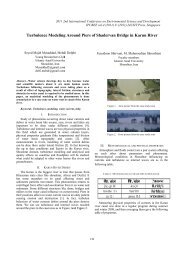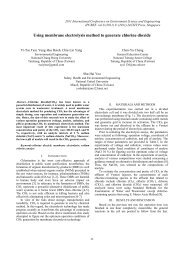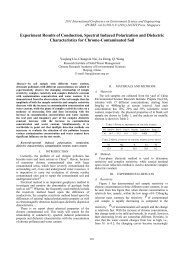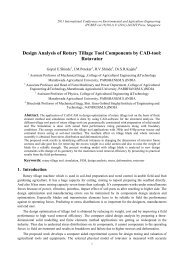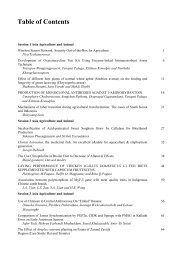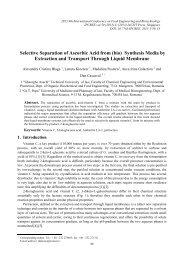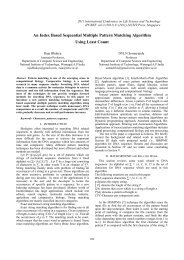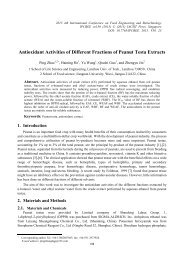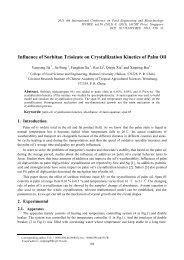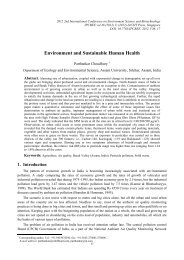Total Phenolic Content and Antioxidant Activities of Palm ... - ipcbee
Total Phenolic Content and Antioxidant Activities of Palm ... - ipcbee
Total Phenolic Content and Antioxidant Activities of Palm ... - ipcbee
You also want an ePaper? Increase the reach of your titles
YUMPU automatically turns print PDFs into web optimized ePapers that Google loves.
2011 2nd International Conference on Biotechnology <strong>and</strong> Food Science<br />
IPCBEE vol.7 (2011) © (2011) IACSIT Press, Singapore<br />
<strong>Total</strong> <strong>Phenolic</strong> <strong>Content</strong> <strong>and</strong> <strong>Antioxidant</strong> <strong>Activities</strong> <strong>of</strong> <strong>Palm</strong> Puree Prepared From<br />
Various Tenera Varieties<br />
Haswani Maisarah Mustafa, Noriham Abdullah <strong>and</strong> Zainon Md Noor<br />
Faculty <strong>of</strong> Applied Sciences<br />
Universiti Teknologi MARA<br />
40450Shah Alam, Selangor Darul Ehsan, Malaysia<br />
E-mail: dextrous_p<strong>and</strong>a84@yahoo.com <strong>and</strong> noriham985@salam.uitm.edu.my<br />
Abstract - Four palm puree samples were used in this study<br />
namely <strong>Palm</strong> Puree 1 (PP1), <strong>Palm</strong> Puree 2 (PP2), <strong>Palm</strong> Puree 3<br />
(PP3) <strong>and</strong> <strong>Palm</strong> Puree 4 (PP4). All samples were prepared<br />
from the combination <strong>of</strong> mesocarp fiber <strong>and</strong> crude palm oil <strong>of</strong><br />
Tenera varieties. <strong>Total</strong> <strong>Phenolic</strong> <strong>Content</strong> (TPC) OF <strong>Palm</strong><br />
Puree was determined by Folin-Ciaocalteu assay while<br />
antioxidant activities were determined by Ferric Reducing<br />
<strong>Antioxidant</strong> Power (FRAP), beta-carotene content <strong>and</strong> 1,1-<br />
Diphenyl-2-2picrylhydrazyl (DPPH) assays. <strong>Palm</strong> Puree 4 (PP4)<br />
showed highest TPC <strong>and</strong> FRAP values <strong>of</strong> 412.194 mg GAE/100<br />
g extract <strong>and</strong> 282.03 x 10 3 µM Trolox/g dry weight respectively<br />
as compared to other samples. <strong>Palm</strong> Puree 3 (PP3) exhibited<br />
the highest percentage <strong>of</strong> free radical scavenging (DPPH)<br />
(95.48%) <strong>and</strong> the beta-carotene content (1116.61 mg/kg)<br />
among all <strong>Palm</strong> Puree samples studied.<br />
Keywords- antioxidant activity; <strong>Palm</strong> Puree; mesocarp fiber;<br />
crude palm oil<br />
I. INTRODUCTION<br />
The pericarp <strong>of</strong> oil palm fruit comprises <strong>of</strong> three layers:<br />
the exocarp, mesocarp <strong>and</strong> endocarp [6]. Mesocarp when<br />
undergoes pressing process, it will produce crude palm oil<br />
<strong>and</strong> leaving behind the fiber part. Fiber part that contain high<br />
amount <strong>of</strong> lignin normally used as live feedstock. <strong>Palm</strong> Puree<br />
in this research was developed from the combination <strong>of</strong><br />
certain percentage <strong>of</strong> fiber <strong>and</strong> crude palm oil part. <strong>Palm</strong><br />
Puree is a new food product developed from the combination<br />
<strong>of</strong> certain percentage <strong>of</strong> mesocarp fiber <strong>and</strong> crude palm oil. It<br />
undergoes a series <strong>of</strong> processing steps that include<br />
sterilization, pressing <strong>and</strong> canning to form canned palm<br />
puree. Crude palm oil is considered as one <strong>of</strong> the world’s<br />
richest natural plant sources <strong>of</strong> carotenoids which are<br />
responsible for the bright red-orange in color <strong>of</strong> palm fruit.<br />
The major carotenes that present in crude palm oil namely α-<br />
carotene <strong>and</strong> β-carotene that account for 36% <strong>and</strong> 54%<br />
respectively [9].<br />
The fleshy mesocarp which has fiber in nature produces<br />
palm oil which is used mainly for its edible properties.<br />
Reference [9] reported that one <strong>of</strong> the minor components <strong>of</strong><br />
interest present is the high content <strong>of</strong> phenolic acid <strong>and</strong><br />
flavonoids. <strong>Antioxidant</strong>s are chemical that can delay the<br />
onset <strong>of</strong> the oxidative rancidity that can extend the shelf life<br />
<strong>of</strong> edible fats <strong>and</strong> oil <strong>and</strong> provide longer oxidative stability.<br />
This has led to many <strong>of</strong> researchers’ interest on the various<br />
studies on the effect <strong>of</strong> antioxidant activities <strong>of</strong> the palm fruit<br />
<strong>and</strong> its by-product.<br />
Reference [7] has reported on the total phenolic content<br />
(TPC) <strong>and</strong> 2,2-diphenyl-2- picrylhydrazyl (DPPH) <strong>of</strong> the<br />
phenolic extract <strong>of</strong> oil palm fruit which contain 83.97±20.08<br />
gL -1 GAE per gram extract <strong>and</strong> 61.98 gL -1 TE per gram<br />
extract respectively. Up to date, no study was conducted on<br />
the <strong>Palm</strong> Puree <strong>and</strong> hence this study aim to provide<br />
antioxidant activities information <strong>of</strong> <strong>Palm</strong> Puree using<br />
various assays such as 2,2-diphenyl-2- picrylhydrazyl<br />
(DPPH), β-carotene content, ferric reducing antioxidant<br />
power (FRAP) as well as total phenolic content (TPC).<br />
II. MATERIALS AND METHODS<br />
A. Chemical <strong>and</strong> Apparatus<br />
Ethanol <strong>and</strong> methanol were purchased from J.Kollin, UK.<br />
Folin-Ciocalteu reagent, sodium carbonate (Na 2 CO 3 ), ferric<br />
chloride hexahydrate (FeCl 3 .6H 2 O), starch powder was<br />
purchased from Merck, Germany. Β-carotene, 2,4,6-tris-<br />
2,4,6-tripyridyl-s-triazine (TPTZ), sodium acetate trihydrate,<br />
2,2-diphenyl-1-picrylhydrazyl (DPPH), thiobarbituric acid<br />
reagent, (+) – catechin hydrate, gallic acid <strong>and</strong> Trolox (6-<br />
hydroxy-2,5,7,8-tetramethylchromane-2-carboxylic acid,<br />
97%) st<strong>and</strong>ards were purchased from Sigma Chemical Co.<br />
(St Louis, MO, USA). Glacial acetic acid <strong>and</strong> hexanes were<br />
purchased from J.T.Baker. Hydrochloric acid (HCl),<br />
chlor<strong>of</strong>orm, iso-octane were purchased from R&M<br />
chemicals. Potassium iodide (KI) <strong>and</strong> sodium thiosulphate-5-<br />
hydrate were purchased from Bendosen, UK. All reagents<br />
used were <strong>of</strong> analytical grade unless otherwise stated.<br />
Spectrophotometric analyses were performed using Perkin<br />
Elmer Lambda 35, USA.<br />
B. Sample Preparation<br />
Tenera varieties <strong>of</strong> palm fruits were obtained from Sime<br />
Darby Plantation Sdn. Bhd Banting. Samples were then<br />
collected <strong>and</strong> processed to make <strong>Palm</strong> Puree. <strong>Palm</strong> Puree in<br />
this research was developed from the combination <strong>of</strong> 2%<br />
fiber <strong>and</strong> 98% <strong>of</strong> crude palm oil part namely PP1, PP2, PP3<br />
<strong>and</strong> PP4 which were then packaged in cans <strong>and</strong> stored at<br />
room temperature until used for further analysis. Samples<br />
were subjected to Soxhlet extraction using n-hexane until the<br />
<strong>Palm</strong> Puree was free from oil [7].<br />
C. Determination <strong>of</strong> <strong>Total</strong> <strong>Phenolic</strong> <strong>Content</strong><br />
Samples were measured for total phenolic content<br />
colorimetrically using the Folin-Ciocalteu method [8] with<br />
23
modification. A 200mg <strong>of</strong> sample was extracted for 2 hours<br />
with 2 ml <strong>of</strong> 80% methanol containing 1% hydrochloric acid<br />
at room temperature on incubator shaker <strong>and</strong> set at 200rpm.<br />
The mixture was centrifuged at 3500rpm for 15 minutes <strong>and</strong><br />
the supernatant was kept in amber bottle for further analysis.<br />
A 100µl <strong>of</strong> supernatant was mixed with 0.5ml Folin-<br />
Ciocalteu reagent (diluted 10 times with distilled water). The<br />
solution was added with 7ml <strong>of</strong> distilled water <strong>and</strong> allowed<br />
to st<strong>and</strong> at room temperature for 5 minutes. Then, 1.5ml<br />
sodium bicarbonate (60mg/ml) solution was added to the<br />
mixture <strong>and</strong> left <strong>and</strong> room temperature in dark place for 2<br />
hours. Absorbance was read at 725nm against blank using<br />
UV-Visible spectrophotometer (Perkin Elmer Lambda 35,<br />
USA). A calibration curve was prepared, using a st<strong>and</strong>ard<br />
solution <strong>of</strong> gallic acid (0.2, 0.4, 0.6, 0.8 <strong>and</strong> 1mg/ml). Results<br />
were expressed as gallic acid equivalents mg GAE/100g.<br />
D. DPPH Free Radical Scavenging Assay<br />
The antioxidant activity was carried out through<br />
evaluation <strong>of</strong> free radical scavenging effect on 1,1 –<br />
diphenyl-2-picrylhydrazyl (DPPH). The determination was<br />
based on the method described by [11] with some<br />
modifications. An aliquot (600µl) sample was added to<br />
4.5ml <strong>of</strong> 0.1mM DPPH ethanolic solution. The mixture was<br />
then thoroughly vortex <strong>and</strong> incubated for 20 minutes in dark<br />
condition at room temperature. The absorbance was<br />
measured at 517nm against a blank <strong>of</strong> ethanol. Results were<br />
then expressed as percentage <strong>of</strong> inhibition <strong>of</strong> the DPPH<br />
radical.<br />
Percentage <strong>of</strong> inhibition <strong>of</strong> DPPH radical was calculated<br />
according to the following equation:<br />
% inhibition <strong>of</strong> DPPH =<br />
[(Abs control – Abs sample) / Abs control] x 100<br />
Where Abs control is the absorbance <strong>of</strong> DPPH without<br />
sample.<br />
E. Ferric Reducing <strong>Antioxidant</strong> Power (FRAP) Assay<br />
The FRAP assay was carried out previously as describe<br />
by [2]. The mechanism <strong>of</strong> this method is based on the<br />
reduction <strong>of</strong> ferric 2,4,6-tripyridyl-s-triazine complex (Fe 3+ -<br />
TPTZ) to its ferrous form (Fe 2+ -TPTZ) in the presence <strong>of</strong><br />
antioxidants. The FRAP reagent contain 20mM FeCl 3 6H 2 O,<br />
10mM TPTZ (2,4,6-tripyridyl-s-triazine) solution in 40mM<br />
HCl <strong>and</strong> 0.3M acetate buffer, pH 3.6. It was prepared freshly<br />
<strong>and</strong> incubated at 37 0 C for 10 minutes. The FRAP reagent<br />
was mixed in the ratio <strong>of</strong> 1: 1: 10. Aliquot <strong>of</strong> 100µl sample<br />
was mixed with 2.9ml <strong>of</strong> FRAP reagent. The absorbance <strong>of</strong><br />
the reaction mixture was measured spectrophotometrically<br />
(Perkin Elmer Lambda 35, USA) at 593nm after incubation<br />
at room temperature for 1 hour. Trolox (1000µM) was used<br />
for calibration curve <strong>and</strong> the results were expressed as µM <strong>of</strong><br />
Trolox equivalents per mg fresh weight.<br />
F. β-carotene <strong>Content</strong><br />
The amount <strong>of</strong> β-carotene content in sample was<br />
determined according to [1]. Initially, 0.1g ± 0.001g <strong>of</strong> the<br />
oil sample was weighed into a 25 ml volumetric flask. Test<br />
portion was dissolved with few milliliters <strong>of</strong> solvent <strong>and</strong><br />
diluted to the mark. Sample was measured using 10mm path<br />
length glass cells <strong>and</strong> reading was taken at 446nm. Original<br />
solution was diluted to a measured volume <strong>and</strong> further<br />
reading was taken so that the observed absorptions are<br />
between 0.2 <strong>and</strong> 0.8 optical density. Result was expressed as<br />
β-carotene, in mg/kg.<br />
β-carotene content was calculated according to<br />
calculation below :<br />
383E / Ic<br />
Where :<br />
E - Observed difference between sample solution <strong>and</strong><br />
solvent<br />
I - Path length in cm<br />
c - Concentration used for absorption measurement (in g per<br />
100ml)<br />
G. Statistical Analysis<br />
All data were analyzed using SAS 9.0 s<strong>of</strong>tware. Analysis<br />
<strong>of</strong> variance (ANOVA) <strong>and</strong> Duncan’s multiple range method<br />
were used to compare any significant differences between<br />
samples. Values were expressed as means ± st<strong>and</strong>ard<br />
deviations. Differences were considered significant at p <<br />
0.05. All analysis was carried out in triplicates.<br />
III.<br />
RESULTS AND DISCUSSION<br />
A. <strong>Total</strong> <strong>Phenolic</strong> <strong>Content</strong> (TPC)<br />
The total phenolic content (mg/100g) in sample was<br />
determined from equation <strong>of</strong> calibration curve (y = 0.1855x<br />
+ 0.253, R² = 0.9814) <strong>and</strong> expressed in gallic acid equivalent.<br />
Results showed that the levels <strong>of</strong> phenolic compounds in<br />
different palm purees were significantly (p < 0.05) different<br />
from each other. The results in TABLE I revealed that the<br />
phenolic content was in order <strong>of</strong> PP4 > PP3 > PP2 > PP1<br />
with values <strong>of</strong> 412.19, 267.25, 195.61 <strong>and</strong><br />
TABLE I. AMOUNT OF TOTAL PHENOLIC CONTENT IN<br />
PALM PUREE SAMPLES<br />
Sample<br />
PP1<br />
PP2<br />
PP3<br />
PP4<br />
TPC<br />
(mg GAE/100g extract)<br />
155.30 d<br />
195.61 c<br />
267.25 b<br />
412.19 a<br />
Note: Analysis data were obtained from triplicate samples<br />
a-d Means with the different letter within the column are significant different (p < 0.05)<br />
155.30 mg GAE/ 100g extract, respectively. The total<br />
phenolic contents <strong>of</strong> PP4 possessed much higher total<br />
phenolic contents than other samples.<br />
24
samples.<br />
According to [3], total phenolic compound that exceeded<br />
16.71 mg GAE/100 g samples gave high antioxidant activity.<br />
Note: Analysis data were obtained from triplicate<br />
a-d:<br />
Means with the different within the column are significant different (p < 0.05)<br />
PP4<br />
282.03 x 10 3a related products <strong>and</strong> others,” MPOB p2.3, 2005, pp. 172-177.<br />
Hence, all <strong>of</strong> the <strong>Palm</strong> Puree samples which were obtained Results from TABLE II showed that samples were<br />
from this study gave high antioxidant activity.<br />
identified according to descending order <strong>of</strong> PP4 > PP3 ><br />
PP2 > PP1 with values <strong>of</strong> 282.03 x 10<br />
B. 2,2 –diphenyl-1-picrylhydrazyl (DPPH)<br />
, 140.87 x 10 3 , 29.90 x<br />
10 3 <strong>and</strong> 12.02 x 10 3 µM Trolox/100g fresh weight<br />
Butylhydroxyanisole (BHA) is a common commercial respectively. Reference [10] classified medicinal plants into<br />
synthetic antioxidant that has been added into food products. their antioxidant capacity as very low FRAP (< 10 µM/100g),<br />
BHA is also use as st<strong>and</strong>ards for comparing antioxidant low FRAP (10 – 50 µM/100g), good FRAP (50 – 100<br />
potential. Fig. 1 showed that the percentage scavenging µM/100g), high FRAP (100 – 500 µM/100g) <strong>and</strong> very high<br />
effect <strong>of</strong> samples over BHA <strong>and</strong> Trolox as st<strong>and</strong>ards. All FRAP(>500 µM/100g). From this experiment, we can<br />
samples were capable <strong>of</strong> scavenging DPPH free radicals. The consider that PP4 possessed much higher FRAP than PP3,<br />
scavenging effect were as the following order: Trolox PP2 <strong>and</strong> PP1.<br />
(97.22%), palm puree 3 (95.48%), palm puree 4 (95.31%),<br />
palm puree 2 (94.99%), palm puree 1 (94.68%) <strong>and</strong> BHA D. β-carotene <strong>Content</strong><br />
(94.34%) at concentration 200µg/ml (200ppm). This result β-carotene present in oil palm fruit in high amount<br />
showed that PP3 could be another potential radical scavenger compared to α carotene, γ carotene <strong>and</strong> other carotene<br />
which can be utilized as food antioxidants replacing the pr<strong>of</strong>iles in palm oil. β-carotene that present in canned palm<br />
commercial synthetic antioxidant such as BHA.<br />
puree <strong>and</strong> expressed in mg/kg. Table III showed the results<br />
<strong>of</strong> palm purees that contain β-carotene content in descending<br />
120<br />
order: PP3 > PP4 > PP2 > PP1 with values <strong>of</strong> 1116.61,<br />
492.35, 304.21 <strong>and</strong> 286.27 mg/kg fresh weight, respectively.<br />
100<br />
TABLE III. THE VALUE OF Β-CAROTENE CONTENT IN PALM<br />
80<br />
Trolox<br />
PUREE SAMPLES<br />
60<br />
BHA<br />
Sample β-carotene content (mg/kg)<br />
PP1<br />
286.27 d<br />
40<br />
pp1<br />
PP2<br />
304.21 c<br />
20<br />
0<br />
pp2<br />
pp3<br />
Note: Analysis data were obtained from triplicate samples<br />
a-d:<br />
Means with the different letter within the column are significant different (p < 0.05)<br />
PP3<br />
1116.61 a<br />
PP4<br />
492.35 b<br />
pp4<br />
Concentration µg/ml<br />
IV. CONCLUSION<br />
This study on total phenolic content <strong>and</strong> antioxidant<br />
Figure 1. Percentage free radical scavenging activity <strong>of</strong> PP1, PP2, PP3, activities on palm puree from various Tenera varieties has<br />
PP4, BHA <strong>and</strong> Trolox<br />
beneficial input to the crude palm oil industry as well as food<br />
industry because it provides new information which can lead<br />
C. Ferric Reducing <strong>Antioxidant</strong> Power (FRAP)<br />
to the new food product development. The screening <strong>of</strong><br />
FRAP assay measures the reducing potential <strong>of</strong> an phenolic compound <strong>and</strong> the antioxidant activities were found<br />
antioxidant reacting with a ferric tripyridyltriazine (Fe 3+ – to be very useful tools to provide in depth the characteristic<br />
TPTZ) complex <strong>and</strong> producing a colored ferrous <strong>of</strong> phenolics that are present in crude palm oil. These results<br />
tripyridyltriazine (Fe 2+ –TPTZ) [2]. Generally, the reducing can initiate the food industry to develop a new food product<br />
properties are associated with the presence <strong>of</strong> compounds, <strong>and</strong> also stimulates the use <strong>of</strong> palm puree as a new value<br />
which exert their action by breaking the free radical chain added food ingredients.<br />
through donating a hydrogen atom [4], [5]. According to [2],<br />
the reduction <strong>of</strong> Fe 3+ –TPTZ complex to blue colored <strong>of</strong> Fe 2+<br />
ACKNOWLEDGMENT<br />
–TPTZ occurs at low pH.<br />
The authors would like to acknowledge the laboratory<br />
facilities provided by Universiti Teknologi MARA Shah<br />
TABLE II. THE VALUE OF FRAP IN PALM PUREE SAMPLES Alam <strong>and</strong> Sime Darby for funding this research (Grant No:<br />
Sample<br />
FRAP (µM Trolox/100g<br />
100-RMI.P 37/7/2005).<br />
fresh weight)<br />
REFERENCES<br />
PP1<br />
12.02 x 10 3d<br />
PP2<br />
29.90 x 10 3c<br />
[1] K. Ainie, S.W. Lin, A.I. Nor, Y. Mohtar, T.T. Sue, <strong>and</strong> A, I. Nuzul,<br />
“Malaysian <strong>Palm</strong> Oil Board (MPOB) test methods: a compendium <strong>of</strong><br />
PP3<br />
140.87 x 10 3b<br />
test on palm oil products, palm kernel products, fatty acids, food<br />
Scavenging Effect (%)<br />
25
[2] I.F.F. Benzie, <strong>and</strong> J.J. Strain, “The ferric reducing ability <strong>of</strong> plasma<br />
(FRAP) as a measure <strong>of</strong> ‘<strong>Antioxidant</strong> Power’: The FRAP assay,”<br />
Analytical Biochemistry, 239,1996, pp. 70-76.<br />
[3] Duh. <strong>and</strong> Yen. G.C, “Antioxidative activity <strong>of</strong> three herbal water<br />
extracts. Food Chemistry, 1997, 6, 639-645.<br />
[4] P.D. Duh, Y.Y. Tu, <strong>and</strong> G.C. Yen, “<strong>Antioxidant</strong> activity <strong>of</strong> water<br />
extract <strong>of</strong> Harng Jyur (Crysanthemum morifolium Ramat),”<br />
Lebnesmitel-Wissenschaft und Technologie, 32, 1999, pp. 269-277.<br />
[5] M. H. Gordon, “The mechanism <strong>of</strong> antioxidant action in vitro. In<br />
Food <strong>Antioxidant</strong>s,” ed. B. J. F. Hudson. Elsevier, London/New York,<br />
1990, pp. 1-18.<br />
[6] H. L. N. Lau, Y. M. Choo, A. N. Ma, <strong>and</strong> C. H. Chuah,“Quality <strong>of</strong><br />
residual oil from palm-pressed mesocarp fiber (Elaeis guineensis)<br />
using supercritical CO2 with <strong>and</strong> without ethanol,” Journal <strong>of</strong> the<br />
American Oil Chemists Society, 83, 2006, pp. 893–898.<br />
[7] Y.P. Neo, A. Ariffin, C.P Tan, <strong>and</strong> Y.A. Tan, “Determination <strong>of</strong> oil<br />
palm fruit phenolic compounds <strong>and</strong> their antioxidant activities using<br />
spectrophotometric methods,” International Journal Food Science <strong>and</strong><br />
Technology, 43, 2008, pp. 1832-1837.<br />
[8] V.L. Singleton, <strong>and</strong> J.A. Rossi, “Colorimetry <strong>of</strong> total phenolics with<br />
phosphomolybdic-phosphotungstic acid reagents,” American Journal<br />
<strong>of</strong> Enology <strong>and</strong> Viticulture, 16, 1965, pp. 144-158.<br />
[9] K. Sundram, R Sambanthamurthi, <strong>and</strong> Y.A. Tan, “<strong>Palm</strong> fruit<br />
chemistry <strong>and</strong> nutrition,” Asia Pacific Journal Clinical Nutrition,<br />
2003, 12(3), pp. 355-362.<br />
[10] A. Wojdylo, J. Oszmiański, <strong>and</strong> R. Czemerys, “<strong>Antioxidant</strong> activity<br />
<strong>and</strong> phenolic compounds in 32 selected herbs. Food Chemistry, 105,<br />
2007, pp. 940-949.<br />
[11] T . Yamaguchi, H. Takamura, T. Matoba, <strong>and</strong> J. Terao, “HPLC<br />
method for evaluation <strong>of</strong> the free radical scavenging activity <strong>of</strong> foods<br />
by using 1,1-diphenyl-2-picrylhydrazyl.,” Bioscience, Biotechnology<br />
<strong>and</strong> Biochemistry, 62, 1998, pp. 1201-1204.<br />
26





